A Glacier’s Pace: Slow Adventures in New Zealand
From Māori legends to penguin crossings—retirees Tim and Teresa explore the far side of the world, one breathtaking moment at a time.
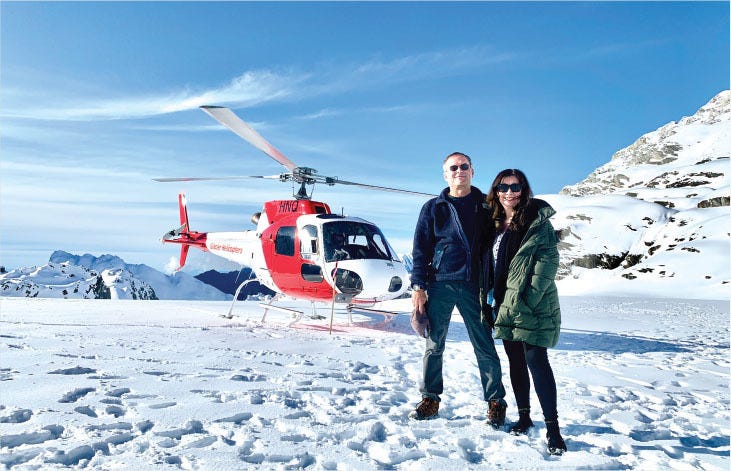
On our last night in Tekapo, New Zealand, the Milky Way arched above us so brightly we felt we were viewing it from outer space…
There was so much infinity drawing me skyward, it seemed ridiculous that my feet were still attached to the ground.
Dream of New Zealand, and you’ll doubtless conjure images of whitecapped mountains rising from deep-blue fiords (spelled with an "i" in New Zealand), smoldering volcanoes and tattooed Māori warriors dancing the fearsome haka, and adorable kiwi birds poking their way through dense jungles.
We dreamed this dream, my wife Teresa and I. Yet for decades, New Zealand eluded us.
We love to travel… and have been to every inhabited continent. But New Zealand was too far… from everywhere. From New York, it’s 9,000 miles via a 16-hour direct flight on New Zealand Airlines. Since we retired in 2021, we’ve lived mostly in Europe, and New Zealand is exactly on the opposite side of the world from Spain.
Luckily, retirement gave us the option for an extended long-haul holiday. So, when the pandemic was over in 2023, we decided it was now or never, New Zealand, and we were going to make the absolute most of it.
Book Off-Season, Wander Aimlessly
Most visitors come here for a week or two. But we believe in slow travel… and a New Zealand tourist visa lasts 90 days.
That means time to explore the highways and byways at a leisurely pace… time to savor each moment and each place.
The way forward was clear: We would rent an electric car and travel up and down the country for the whole three months.
Since we chose the cooler winter months (June to August), we knew it would be off season, which meant we didn’t have to book our entire trip in advance. This allowed us to meander off the beaten tourist-track, to linger wherever we wanted, explore quirky little towns, listen to people tell us their stories, and savor every dramatic mountain, glacier, beach, and volcano.
Here are four of our favorite adventures from the land of the kiwi…
A Fierce Māori Welcome in Waitangi
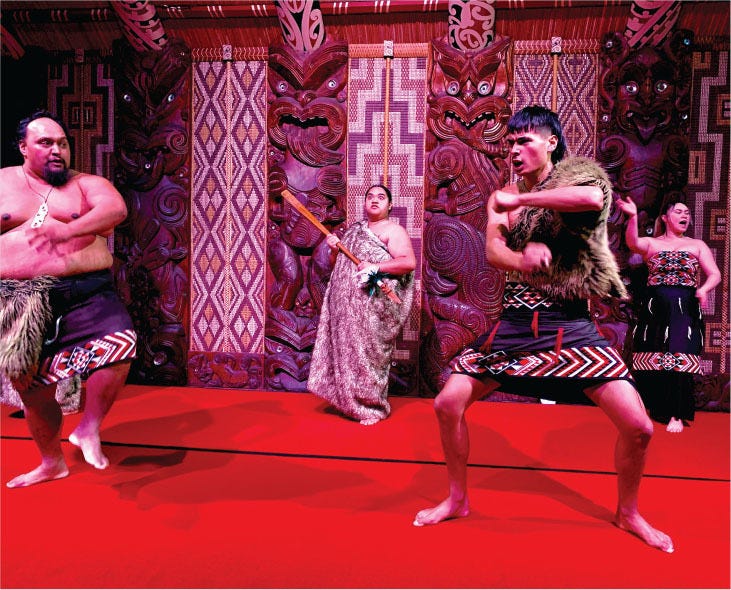
The warrior ran towards me, spear held high over his shoulder, eyes bulging menacingly. I knew not to flinch, and definitely not to turn my back on him. I was in Māori territory, and I had my instructions.
He stopped a few feet away from me and glared. Then he twirled his spear like a Kungfu master. "Ou!" he grunted loudly. "Ou! Ou!" Not taking his eyes from me, he bent to pull a leafy twig from beneath his robe and set it on the ground.
We 30-odd visitors to Waitangi shuffled our feet and looked about, seeing if anyone had the nerve to make a move.
Teresa tilted her head sideways in my direction. Our Māori hostess caught the gesture. Her eyes lit up, and she beckoned me forward. I grimaced at Teresa. She smiled innocently at me…
I stepped forward, knelt and picked up the offered leaves, then backed away, slowly.
Māori warrior culture developed around the need to protect their territory from ambitious neighbors. My response to his offering would determine whether we would be treated as friends who come in peace… or as enemies who must be fought. Fortunately, I had been told exactly what to do.
The Māori warrior sprinted to rejoin the other members of his tribe. Together they sang and danced a ritual invitation to enter their sacred communal space—an elaborately carved wooden hall filled with statues of ancestors and mythical beings.
When we were all seated inside, the chief began his welcome speech, bellowing at us in te reo Māori (the Māori language). He was a large man in that Polynesian way that appears massive without looking out of shape. He gestured aggressively, shaking his spear at us. Although this was a cultural performance, it was very intense and felt very genuine… whatever he was saying.
Suddenly he switched to English.
"We hope you all enjoy the show!" he told us with a broad smile.
The performance that followed included dances and songs with explanations in English of how the Māori ancestors came to New Zealand—a thousand years ago—by sea canoe from Polynesia. They demonstrated hand-tohand combat techniques with spears and bone choppers, and explained the meaning of the carvings and adornments on their weapons. Those colorful feathers bunched behind the spear tip? They’re more than decorative. They soak up blood and prevent the spear handle from getting slippery.
The troupe showed us the whimsical side of Māori life as well. They played games with swinging balls and passing sticks, tossing them back and forth with mesmerizing precision. It was a beautiful introduction to Māori culture and history.
Waitangi, where we watched the performance, is a small rural settlement on the North Island of New Zealand. Sacred to the Māori, you might call it the birthplace of the new nation. We’d made the three-hour drive north from Auckland to see it—this green hill where, in 1840, some 50 Māori chiefs and the representative of the King of England first signed the Treaty of Waitangi, which created the British colony of New Zealand. The treaty was taken all around the islands and eventually signed by over 500 chiefs.
Franz Josef: A Glacier in a Rainforest
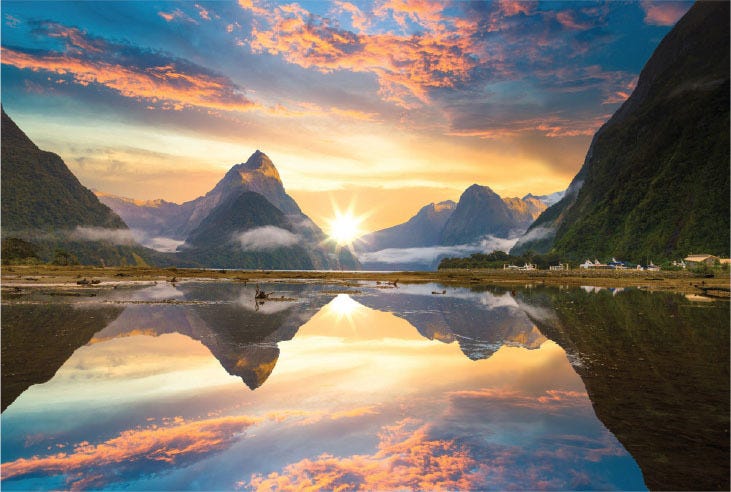
Franz Josef is one of the largest of New Zealand’s 2900 glaciers: 7.5 miles long at present, but shrinking fast.
The village of Franz Josef is on the western coast of the South Island, about a five-hour drive from Queenstown. The day we arrived, the prospect of seeing this glacier up close compelled me out the door to hike to the nearest lookout…
But when I got there, all I saw was a vast gravel riverbed with a dense wall of clouds beyond it. According to a placard, the glacier once flowed right down to this spot. But over the past 150 years, it’s melted away, retreating about two miles up the valley. That day, it was invisible behind the fog.
The rain and mist persisted until the final day of our stay at Franz Josef. I was off on a hike, when suddenly the sky cleared. I raced back to our hotel. There was only one remaining option if we were going to get a close-up view of a glacier.
"Hey sweetheart, how about a helicopter ride?" I said to Teresa, shocking the pants off her. I’m not prone to splurges and it would cost $200 each for the 25-minute round trip. But this was a once-in-a-lifetime chance to fly over a glacier and touch down right at the top.
"Absolutely!" Though Teresa gets a bit of vertigo sometimes, she seemed quite nonchalant about this little jaunt.
An hour later we were strapped into our seats in a plexiglass dome, rotors whirling overhead. We lifted off into the cerulean sky and soared towards the glacier, hugging the high green walls of the valley, our delicate bubble swaying gently from side to side with each adjustment of our course. In minutes we had Franz Josef in sight, and for the first time I could see its massive forked tongue, mineral blue and jagged at the edge.
We flew right over the tongue and the icefield that had given birth to the glacier thousands of years ago. The newly fallen snow was a brilliant white, and behind me I could see clear down the valley to the Tasman Sea.
Graceful as a bee alighting on a flower, our pilot set the helicopter down on a flat space of hardpacked snow. He hopped out and set us free, but told us not to go too far; we couldn’t tell exactly where the snow curved off the edge of our little perch. We staggered around a bit, disoriented by the thin air and sheer exhilaration of being in this bright ice palace in the sky, among the frozen brother-gods of legend.
"Nice job you’ve got," I said to the pilot. "You get to make people crazy happy every day."
"Yeah," he drawled, looking around from the peaks to the ocean at the end of the valley. "This is my office."
As we climbed back on board, I offered Teresa my window seat. She looked at me like I was nuts.
"No!"
"But you’ll see so much more."
"I doubt it," said my beloved. "I had my eyes closed almost the whole way up!"
Penguins on the Otago Peninsula
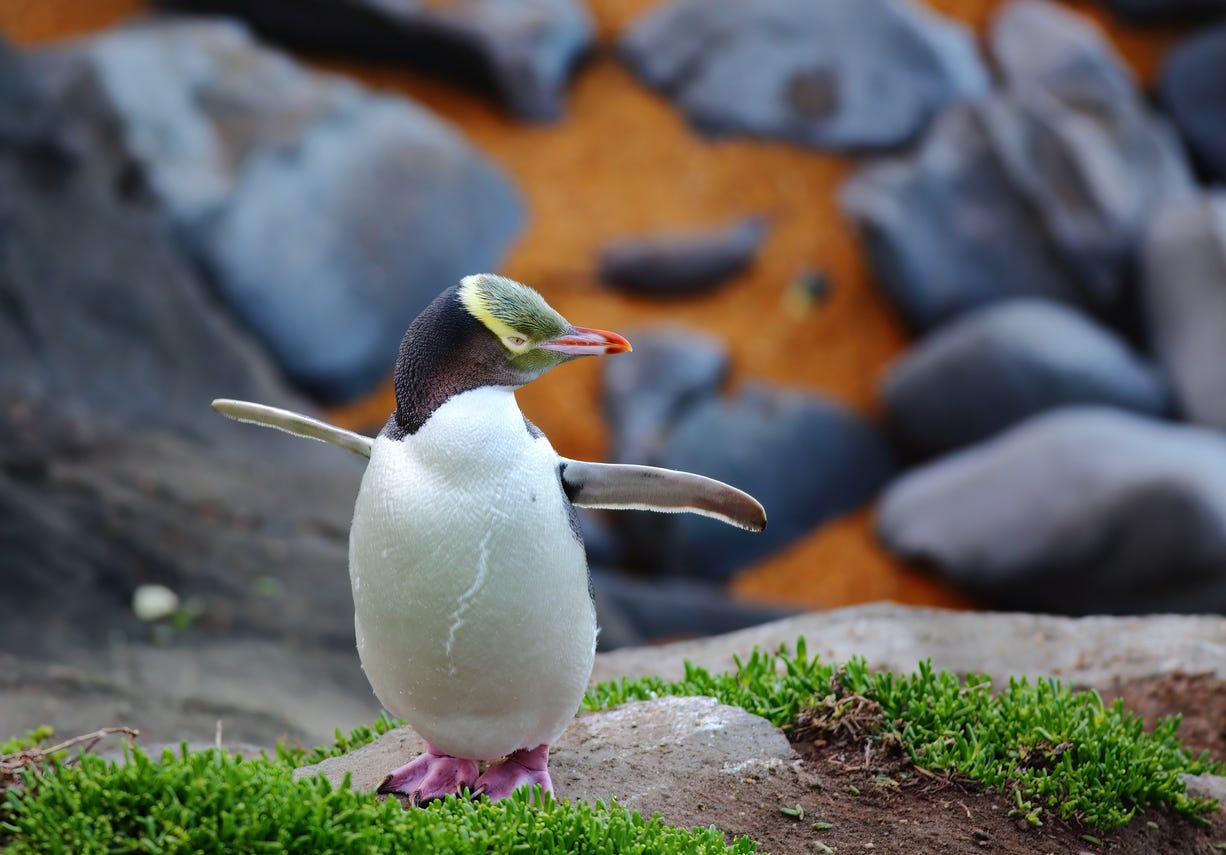
If you didn’t know, there are penguins in New Zealand—several breeds in fact, including "little blue penguins," or kororā, as the Māori call them.
At the end of the Otago Peninsula on the east coast of the South Island, an eco-venture outfit built a kororā viewing platform near where we were staying. It was the perfect opportunity to see them.
The tiniest penguins in the world, they average a foot tall and weigh about 2.5 pounds. Though not endangered, the kororā are in decline, and their biggest threats in New Zealand are not sea lions, not sharks, but cars—the penguins travel up to 600 feet inland, often crossing roads at dusk. They’re small, fast, and hard to see. New Zealand is the only place in the world where I’ve seen "Penguins Crossing" road signs.
In summer, during nesting season, some 300 kororā shelter here. But in midwinter, we were told to expect 20 to 30 birds. That was enough for an exciting hour’s viewing on a freezing-cold evening. We huddled behind the wooden boards of a barricade and waited.
At dusk the little penguins began popping up out of the water in small teams of three to eight. Each cluster would race up the bank, right below us, and then disappear into the tufts of tussocks where they had their nests. The penguins don’t fear us humans, our guides said, because they see us as safely "caged" behind the barricade—and indeed, they seemed totally oblivious to our presence.
The only place in the world where I’ve seen ‘Penguins Crossing’ road signs.
To run, a kororā has to flap its tiny flippers in opposite directions, so its whole body careens from side to side. Every now and then, one would stop and stretch out its tiny wings in the freezing wind, then shake the water off its sleek white belly and shiny blue back—yes, they are actually navy blue!
I could sense how comfortable, happy even, they were in the intense cold wind that was turning me into a popsicle. I felt such admiration for these little birds—so tiny, so tough, so fearless—and I realized how very much I want to live in a world with plenty of penguins.
Dark Night, Bright Stars
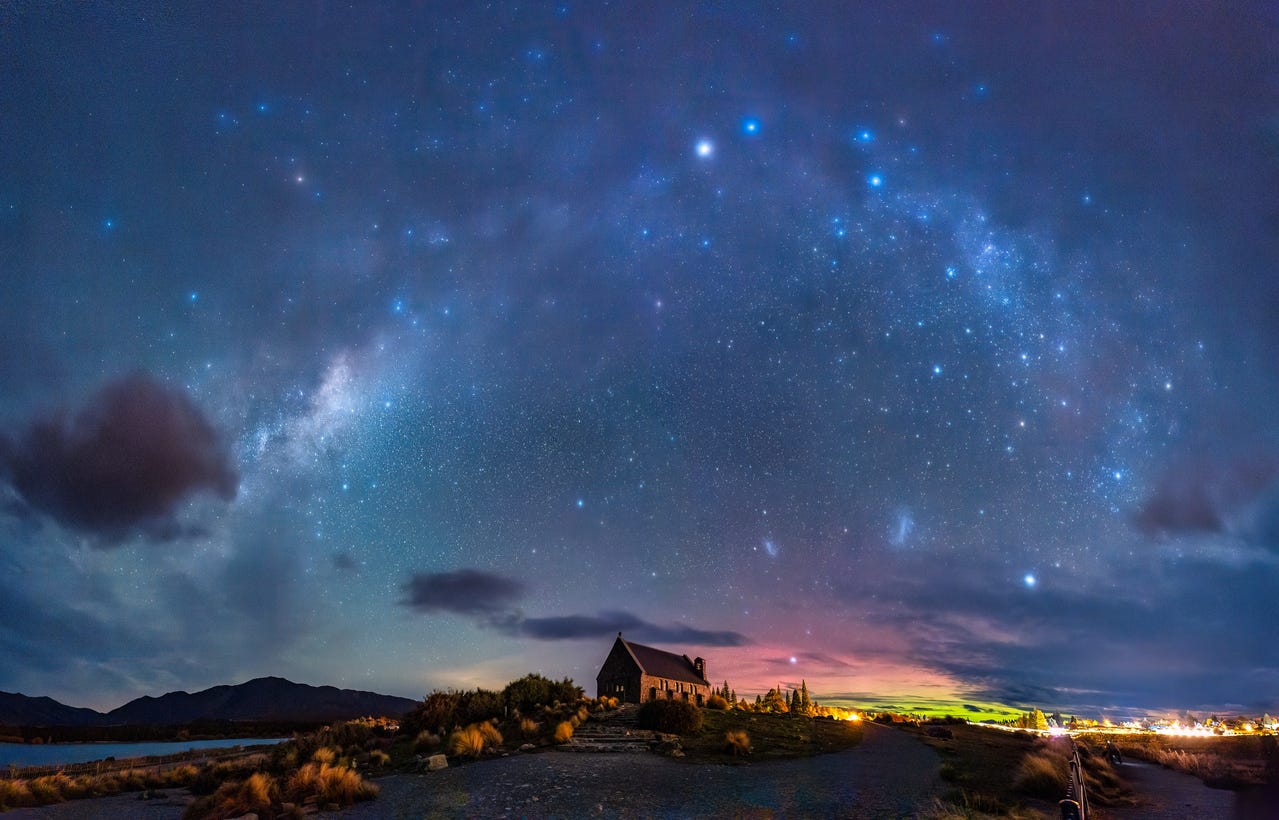
The little town of Tekapo, in remote MacKenzie County in the center of the South Island, has one of the darkest night skies in the world.
Why? There’s simply no light beneath it.
To the north, east, and south, the nearest villages are more than 90 miles away. To the west, there is nothing but sheep farms all the way to the coast. As a result, this whole region has been declared a "Dark Sky Reserve"—the largest of its caliber in the world.
Here on the peak of Mount John are four world-class telescope observatories. The astronomy department of the University of Canterbury conducts research projects at the facilities, and generously shares them with astronomers from around the world. It gives them the best view of the southern sky in the world.
In partnership with the university and Māori-run Ngāi Tahu Tourism, the Dark Sky Experience Company takes groups of a hundred or so to the top of Mount John each night to watch the heavens through their telescopes.
Dark Sky tours are so popular they were nearly sold out for our four-day stay in Tekapo. The night we were due to go, cloud cover rolled in and the tour was canceled. But we didn’t mind so much… The Dark Sky Center has a beautiful display about Māori astronomy and the legends of the ancestors in the constellations.
The best view of the southern sky in the world.
Plus, stepping outside our door on a moonless night was all we needed to experience the magic of the Milky Way—less "milky" here and more like a celestial bubble tea, with tiny globes of light suspended in the black bowl of night.
Standing there, I could sense the depth, the spaciousness of space. Imagine a world in which the night sky is dark everywhere? How might we change, as a species, if simply looking up each night reminded us of our tiny place in the universe—and we lost our cares in the infinity of space?
"Millions of children across the world will never see a star, let alone appreciate the Milky Way. We believe that, together, we can change this. The night sky should be accessible to everyone on the planet—tonight, tomorrow and into the future." —The Dark Sky Reserve Project
What to Know Before You Go
To maximize flexibility, travel in the offseason (May-October) when it’s easy to book accommodations.
Visitors from the US and Canada are granted a 90-day tourist visa on arrival, but you can apply online in advance for a 6-9 month extended stay visa.
Driving is the best way to explore. Rental cars are much cheaper by the month. And renting an electric vehicle you will save about 60% on fuel.
Focus on the North Island for culture and the South Island for outdoor adventure.
New Zealand food is not that exciting: expect pizza, burgers everywhere. You can find fine dining, but you have to do your research.
Clean your boots and hiking gear thoroughly before you enter the county. New Zealand is serious about keeping out soil-borne plant diseases. Customs will fine you heavily if they find mud on your gear!
This story first appeared in the pages of International Living magazine. Want more tales and expert insights like this? Click here to learn more.
Editor’s Note: Tim Ward is the globetrotting author of eleven books, including the Mature Flâneur duology. A flâneur is someone who wanders without a fixed destination—and New Zealand proved the perfect place to do just that. Tim was so struck by the country’s diversity and natural wonder that he wrote a whole book about it: Mature Flâneur in New Zealand: Slow Travels in the Land of the Kiwi.


